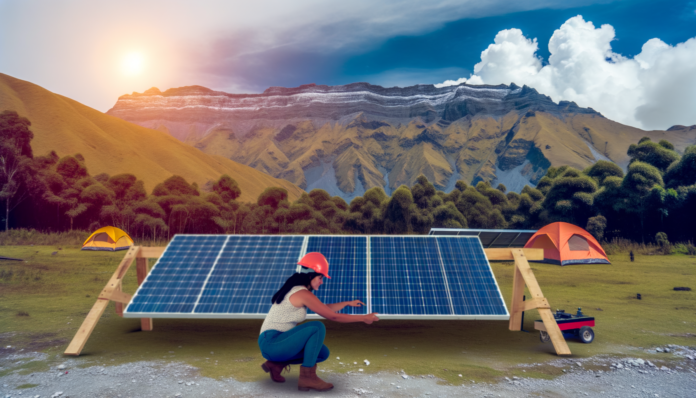Introduction
Overview of Solar Panels for Outdoor Adventures
Solar panels have revolutionized the way we approach outdoor adventures, providing a sustainable and reliable source of energy for various activities such as camping, hiking, and RVing. These panels harness the power of the sun to generate electricity, allowing adventurers to power essential devices like GPS units, smartphones, lights, and even small appliances. With the increasing popularity of off-grid living and eco-friendly travel, solar panels have become indispensable for those who seek to explore the great outdoors without compromising on comfort and convenience.
Importance of Choosing the Right Solar Panel
Selecting the right solar panel is crucial for maximizing the benefits of solar energy during your adventures. The efficiency, durability, and portability of the solar panel can significantly impact your overall experience. A well-chosen solar panel ensures that you have a consistent and adequate power supply, reducing the need for backup power sources like generators, which can be noisy and environmentally unfriendly. Moreover, the right solar panel can save you money in the long run by reducing fuel costs and minimizing the need for frequent replacements. Therefore, understanding the different types of solar panels and their respective advantages and disadvantages is essential for making an informed decision.
Purpose and Scope of the Article
The purpose of this article is to provide a comprehensive comparison between monocrystalline and polycrystalline solar panels, helping you choose the best option for your outdoor adventures. We will delve into the technical aspects of each type, including their efficiency ratings, performance in various weather conditions, durability, and cost-effectiveness. By the end of this article, you will have a clear understanding of the key differences between monocrystalline and polycrystalline solar panels, enabling you to make an informed decision based on your specific needs and preferences.
In the following sections, we will explore the fundamental characteristics of monocrystalline and polycrystalline solar panels, compare their performance metrics, and discuss their suitability for different types of outdoor activities. Whether you are a seasoned adventurer or a novice explorer, this guide aims to equip you with the knowledge necessary to harness the power of the sun effectively and sustainably.
Understanding Solar Panel Types
What are Monocrystalline Solar Panels?
Monocrystalline solar panels are crafted from single-crystal silicon ingots. This manufacturing process involves growing silicon into a single continuous crystal structure, resulting in panels that are uniform in appearance, typically dark in color (often black or dark blue). The cells are characterized by rounded edges due to the slicing of cylindrical ingots into square wafers.
Monocrystalline panels are known for their higher efficiency rates, typically around 15-20%, which is derived from the purity and uniformity of their silicon crystals. This allows them to convert sunlight into electricity more effectively. Additionally, monocrystalline panels perform well in low-light conditions and offer extended longevity, making them ideal for installations where space is at a premium.
What are Polycrystalline Solar Panels?
Polycrystalline solar panels, on the other hand, are manufactured using silicon crystals that are melted together to form the panel’s wafers. This process results in a more speckled appearance, with panels typically exhibiting a bluish hue and rectangular shape with cut-off edges.
Polycrystalline panels tend to have lower efficiency rates compared to monocrystalline panels, generally ranging from 13-16%. This is due to the nature of their crystal structure, which affects electron mobility and overall performance. However, they are more cost-effective to produce, making them a popular choice where maximizing cost efficiency is paramount over achieving maximum space efficiency.
Key Differences Between Monocrystalline and Polycrystalline
Understanding the distinctions between monocrystalline and polycrystalline solar panels is essential for making an informed decision. Here are the key differences:
- Efficiency: Monocrystalline panels typically have higher efficiency ratings, around 15-20%, compared to polycrystalline panels which range from 13-16%. This higher efficiency means that monocrystalline panels can generate more electricity per square meter of space, making them advantageous where space for installation is limited.
- Appearance: Monocrystalline panels are sleek and uniformly black, blending well with most roof types and architectural styles. In contrast, polycrystalline panels have a bluish tint and a less uniform appearance due to the multiple crystals they are composed of.
- Cost: Polycrystalline panels are generally more affordable upfront due to simpler production processes and lower silicon waste during manufacturing. This makes them a popular choice for large-scale solar installations where reducing overall project costs is a priority.
- Performance in Low-Light Conditions: Monocrystalline panels perform better in low-light conditions compared to polycrystalline panels, making them more suitable for areas with less consistent sunlight.
- Temperature Coefficient: Monocrystalline panels have a lower temperature coefficient, meaning they are less affected by heat and maintain efficiency better in high temperatures compared to polycrystalline panels.
- Longevity: Both types of panels are durable, but monocrystalline panels tend to have a longer lifespan, often coming with warranties of 25 years or more, compared to polycrystalline panels which may have slightly shorter warranties.
In summary, the choice between monocrystalline and polycrystalline solar panels depends on your specific needs and circumstances. Monocrystalline panels are ideal for those seeking higher efficiency and a sleek appearance, making them perfect for limited space. They perform better in low-light conditions but come at a higher cost. On the other hand, polycrystalline panels are more affordable and have a shorter energy payback time, making them a great option for budget-conscious users with ample roof space.
Performance and Efficiency
Efficiency Ratings of Monocrystalline Panels
Monocrystalline solar panels are renowned for their high efficiency. This is primarily due to the purity of the silicon used in their construction. Each cell is made from a single crystal of silicon, which allows for a more direct path for the electrons, resulting in less resistance and higher efficiency. Typically, monocrystalline panels have efficiency ratings ranging from 15% to 23%. This means they can convert a larger percentage of sunlight into electricity compared to other types of panels. For those with limited space, monocrystalline panels are often the preferred choice because they produce more power per square foot.
Efficiency Ratings of Polycrystalline Panels
Polycrystalline solar panels, on the other hand, are made from silicon crystals that are melted together. This process is less expensive but results in lower efficiency. Polycrystalline panels generally have efficiency ratings between 14% and 17%. While they are less efficient than monocrystalline panels, they are also more affordable. This makes them a viable option for those who have ample space and are looking to minimize upfront costs. However, to achieve the same power output as monocrystalline panels, you will need more polycrystalline panels, which can take up more space.
Performance in Different Weather Conditions
The performance of solar panels can vary significantly based on weather conditions. Monocrystalline panels tend to perform better in low-light conditions, such as cloudy or overcast days. Their higher efficiency allows them to generate more electricity even when sunlight is not at its peak. Polycrystalline panels, while still effective, may see a more noticeable drop in performance under the same conditions.
In terms of durability, both types of panels are designed to withstand various weather conditions, including rain, snow, and wind. However, monocrystalline panels generally have a slight edge in terms of overall performance consistency across different weather scenarios.
Impact of Temperature on Efficiency
Temperature can have a significant impact on the efficiency of solar panels. All solar panels experience a drop in efficiency as temperatures rise, but the extent of this drop can vary between different types of panels. Monocrystalline panels have a lower temperature coefficient, meaning they are less affected by high temperatures compared to polycrystalline panels. This makes them more efficient in hot climates.
Polycrystalline panels have a higher temperature coefficient, which means their efficiency decreases more as the temperature increases. This can be a crucial factor to consider if you plan to use your solar panels in regions with high temperatures. For example, in extremely hot conditions, the efficiency of polycrystalline panels can drop more significantly, reducing their overall power output.
In summary, while both monocrystalline and polycrystalline panels have their own sets of advantages and disadvantages, monocrystalline panels generally offer higher efficiency and better performance in various weather conditions and temperatures. Polycrystalline panels, though less efficient, are more cost-effective and can be a suitable option for those with ample installation space and a tighter budget.
Durability and Longevity
Lifespan of Monocrystalline Panels
Monocrystalline solar panels are renowned for their longevity. Typically, these panels have a lifespan ranging from 25 to 40 years. This extended lifespan is attributed to the high-purity silicon used in their construction, which ensures minimal degradation over time. Manufacturers often back monocrystalline panels with warranties of up to 25 years, reflecting their confidence in the product’s durability and long-term performance. The single-crystal structure of these panels not only enhances efficiency but also contributes to their robustness, making them a reliable choice for long-term solar investments.
Lifespan of Polycrystalline Panels
Polycrystalline solar panels, while slightly less durable than their monocrystalline counterparts, still offer a respectable lifespan of 20 to 35 years. The multiple silicon crystal fragments used in these panels result in a slightly lower efficiency and durability. However, advancements in manufacturing processes have significantly improved their longevity. Polycrystalline panels are also commonly backed by warranties of up to 25 years, ensuring that they remain a viable option for those seeking a balance between cost and durability.
Resistance to Physical Damage
Both monocrystalline and polycrystalline solar panels are designed to withstand various environmental stresses, including hail, wind, and snow loads. However, monocrystalline panels generally exhibit slightly better resistance to physical damage due to their more robust single-crystal structure. This makes them less prone to micro-cracks and other forms of physical degradation over time. Polycrystalline panels, while durable, may be more susceptible to damage under extreme conditions due to the presence of multiple crystal boundaries, which can act as points of weakness.
Maintenance Requirements
Maintenance requirements for both monocrystalline and polycrystalline solar panels are relatively low, making them both attractive options for outdoor adventures. Regular cleaning to remove dust, dirt, and debris is essential to maintain optimal performance. This can typically be done with water and a soft brush or cloth. Additionally, periodic inspections to check for any physical damage or electrical issues are recommended.
Monocrystalline panels, due to their higher efficiency and better performance in low-light conditions, may require less frequent cleaning compared to polycrystalline panels, which can be more affected by shading and dirt accumulation. However, both types of panels benefit from similar maintenance routines to ensure longevity and sustained performance.
In summary, while monocrystalline panels offer a longer lifespan and slightly better resistance to physical damage, polycrystalline panels still provide a durable and cost-effective solution with a respectable lifespan. Both types of panels require minimal maintenance, making them suitable for various outdoor adventures.
Portability and Installation
Weight and Size Considerations
When embarking on an outdoor adventure, the weight and size of your solar panels are crucial factors to consider. **Monocrystalline solar panels** are generally more efficient, which means they can produce more power per square foot compared to **polycrystalline panels**. This efficiency translates into smaller and lighter panels, making them an excellent choice for those who need to minimize the weight and bulk of their gear.
On the other hand, polycrystalline panels, while typically larger and heavier due to their lower efficiency, can still be a viable option if you have ample space and don’t mind the extra weight. For instance, if you’re setting up a base camp or have a vehicle to transport your gear, the size and weight of polycrystalline panels may not be as significant a concern.
Ease of Installation
The ease of installation is another important aspect to consider, especially if you plan to set up and take down your solar panels frequently. **Monocrystalline panels** often come with user-friendly features such as foldable designs and integrated stands, making them easier to deploy and pack away. Their higher efficiency also means you need fewer panels to achieve the same power output, simplifying the installation process.
**Polycrystalline panels**, while generally more cumbersome, can still be straightforward to install if they come with modular designs and easy-to-use mounting systems. However, due to their larger size, you may need more time and effort to set them up, particularly if you’re working alone or in challenging conditions.
Suitability for Different Types of Adventures
The type of adventure you’re planning can significantly influence your choice between monocrystalline and polycrystalline solar panels. Here are some scenarios to consider:
– **Backpacking and Hiking**: For activities where every ounce counts, monocrystalline panels are the clear winner. Their compact size and lightweight design make them easy to carry in a backpack, and their high efficiency ensures you get the most power from the smallest possible setup.
– **Camping and RV Trips**: If you’re camping or traveling in an RV, you have more flexibility in terms of space and weight. Polycrystalline panels can be a cost-effective choice here, especially if you have a larger surface area to install them, such as the roof of an RV or a dedicated solar array at your campsite.
– **Boating and Marine Adventures**: Monocrystalline panels are often preferred for marine applications due to their higher efficiency and better performance in low-light conditions. Their smaller footprint is also advantageous on boats where space is at a premium.
– **Emergency Preparedness**: For emergency situations, portability and ease of use are paramount. Monocrystalline panels, with their higher efficiency and compact design, are typically the better choice. They can be quickly deployed to provide reliable power in critical situations.
In summary, the choice between monocrystalline and polycrystalline solar panels for your adventure depends on your specific needs and constraints. Monocrystalline panels offer higher efficiency and portability, making them ideal for weight-sensitive and space-constrained activities. Polycrystalline panels, while larger and heavier, provide a cost-effective solution for scenarios where space and weight are less of a concern.
Cost and Value for Money
Initial Investment
When considering solar panels for your outdoor adventures, the initial investment is a crucial factor. Monocrystalline solar panels generally come with a higher price tag compared to polycrystalline panels. This is primarily due to the more complex manufacturing process involved in creating single-crystal silicon cells. Monocrystalline panels are known for their higher efficiency and better performance, which justifies their higher cost. On the other hand, polycrystalline panels are less expensive because their production process is simpler, involving the melting and molding of multiple silicon fragments.
For adventurers on a budget, polycrystalline panels might seem like the more attractive option due to their lower upfront cost. However, it’s essential to weigh this against the efficiency and space requirements. If you have limited space for solar panels, investing in the more efficient monocrystalline panels could be more beneficial in the long run.
Long-term Savings
While the initial cost of monocrystalline panels is higher, their superior efficiency can lead to significant long-term savings. These panels convert a larger percentage of sunlight into electricity, meaning you get more power output per square foot. This higher efficiency translates to fewer panels needed to meet your energy requirements, which can be particularly advantageous in space-constrained setups like RVs or boats.
Polycrystalline panels, although less efficient, can still offer substantial savings over time. They are durable and can perform well in various conditions, albeit with a slightly lower efficiency. If you have ample space to install more panels, the lower cost of polycrystalline panels can offset their reduced efficiency, making them a viable option for long-term savings.
Return on Investment
The return on investment (ROI) for solar panels depends on several factors, including the initial cost, efficiency, and the amount of sunlight your panels will receive. Monocrystalline panels, with their higher efficiency, often provide a quicker ROI despite their higher initial cost. This is because they generate more electricity over their lifespan, reducing the need for additional panels and potentially lowering installation costs.
Polycrystalline panels offer a slower ROI due to their lower efficiency. However, their lower initial cost can make them an attractive option for those looking to minimize upfront expenses. It’s also worth noting that both types of panels are eligible for federal solar tax credits, which can significantly reduce the overall cost and improve ROI.
In summary, while monocrystalline panels require a higher initial investment, their superior efficiency and performance can lead to greater long-term savings and a quicker ROI. Polycrystalline panels, with their lower upfront cost, offer a more budget-friendly option with a slower but still substantial ROI. Your choice will ultimately depend on your specific needs, budget, and the space available for installation.
Conclusion
Summary of Key Points
In this article, we have explored the differences between monocrystalline and polycrystalline solar panels, focusing on their suitability for outdoor adventures. Monocrystalline panels are known for their high efficiency, space efficiency, and longevity, making them ideal for applications where space is limited and maximum power output is crucial. On the other hand, polycrystalline panels offer a cost-effective solution with good performance in diffuse light conditions, making them suitable for larger installations where budget considerations are important.
Recommendations Based on Different Needs
Choosing the right solar panel depends on your specific needs and circumstances. Here are some recommendations based on different scenarios:
- Limited Space: If you have limited space on your adventure gear, such as a small boat or RV, monocrystalline panels are the best choice due to their higher efficiency and power output per square foot.
- Budget Constraints: If you are on a tight budget but still want reliable solar power, polycrystalline panels offer a more affordable option while still providing decent efficiency and performance.
- Harsh Environments: For adventures in harsh environments with extreme weather conditions, monocrystalline panels are recommended due to their durability and longer lifespan.
- Large Installations: If you have ample space and are looking to set up a large solar array, polycrystalline panels can be a cost-effective solution, especially in regions with diffuse light conditions.
Final Thoughts on Choosing the Right Solar Panel
Selecting the right solar panel for your outdoor adventure is a critical decision that can significantly impact your energy efficiency, cost savings, and overall experience. Both monocrystalline and polycrystalline panels have their unique advantages and are suitable for different applications. By carefully considering factors such as space availability, budget, environmental conditions, and specific energy needs, you can make an informed decision that best suits your adventure requirements.
In conclusion, whether you opt for the high efficiency and compact design of monocrystalline panels or the cost-effectiveness and good performance of polycrystalline panels, investing in solar power is a step towards sustainable and reliable energy for your outdoor adventures.






